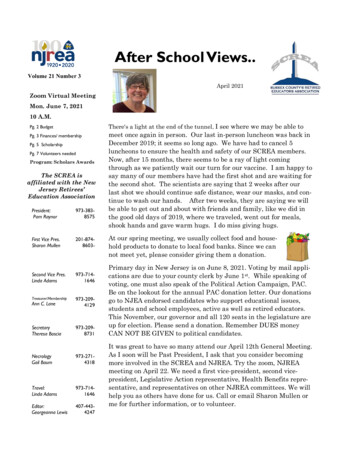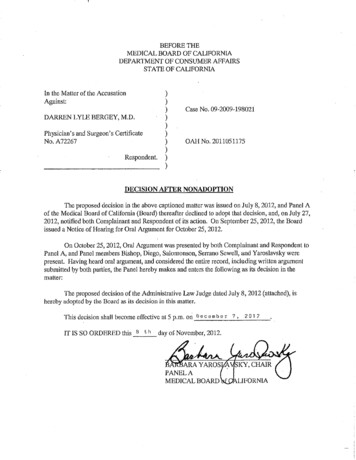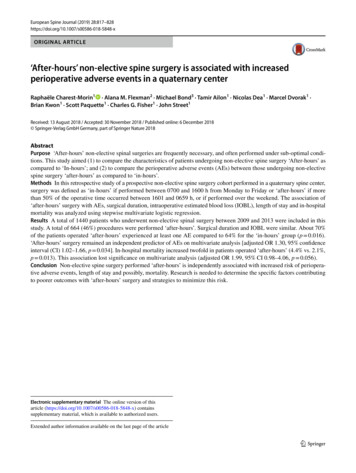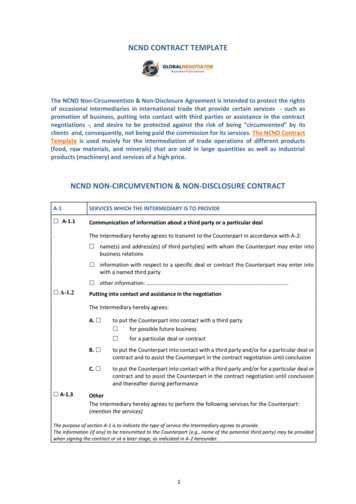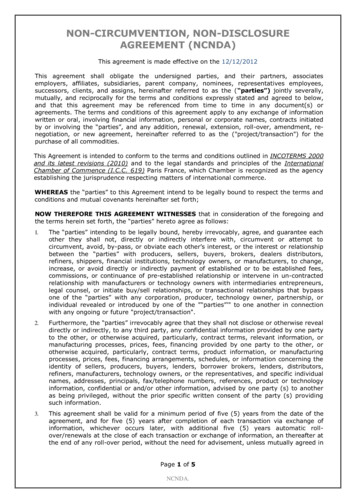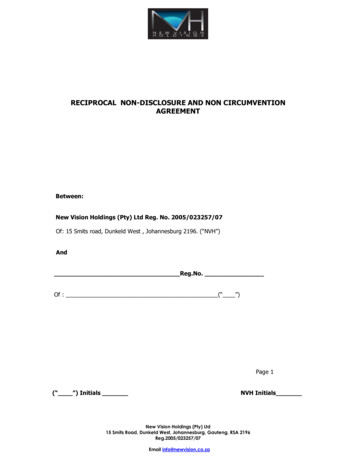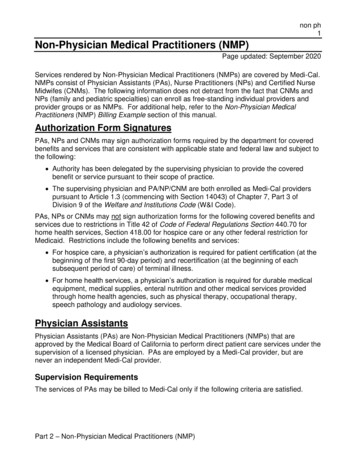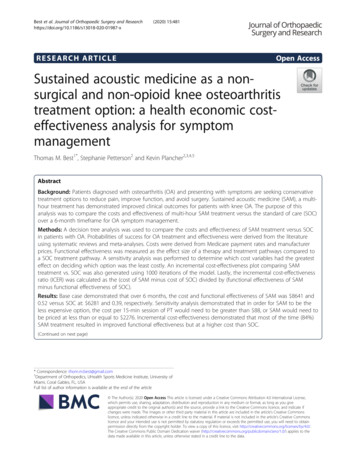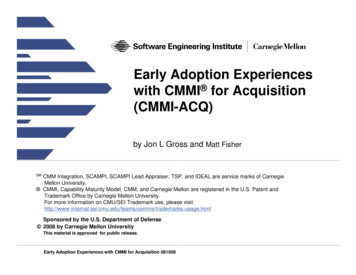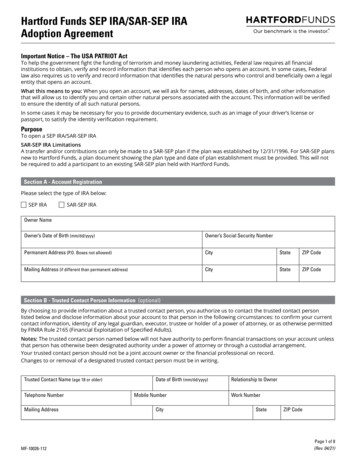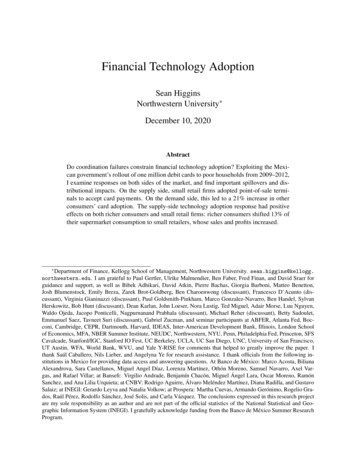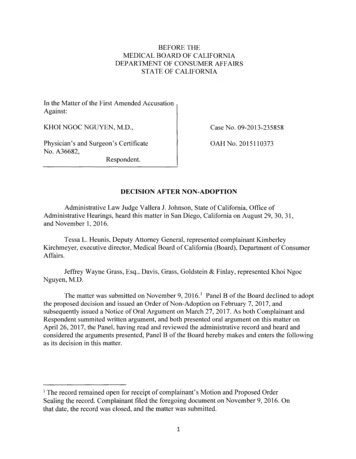
Transcription
BEFORE THEMEDICAL BOARD OF CALIFORNIADEPARTMENT OF CONSUMER AFFAIRSSTATE OF CALIFORNIAIn the Matter of the First Amended AccusationAgainst:KHOI NGOC NGUYEN, M.D.,Case No. 09-2013-235858Physician's and Surgeon's CertificateNo. A36682,Respondent.OAH No. 2015110373DECISION AFTER NON-ADOPTIONAdministrative Law Judge Vallera J. Johnson, State of California, Office ofAdministrative Hearings, heard this matter in San Diego, California on August 29, 30, 31,and November 1, 2016.Tessa L. Heunis, Deputy Attorney General, represented complainant KimberleyKirchmeyer, executive director, Medical Board of California (Board), Department of ConsumerAffairs.Jeffrey Wayne Grass, Esq., Davis, Grass, Goldstein & Finlay, represented Khoi NgocNguyen, M.D.The matter was submitted on November 9, 2016. 1 Panel B of the Board declined to adoptthe proposed decision and issued an Order ofNon-Adoption on February 7, 2017, andsubsequently issued a Notice of Oral Argument on March 27,2017. As both Complainant andRespondent summited written argument, and both presented oral argument on this matter onApril 26, 2017, the Panel, having read and reviewed the administrative record and heard andconsidered the arguments presented, Panel B of the Board hereby makes and enters the followingas its decision in this matter.1The record remained open for receipt of complainant's Motion and Proposed OrderSealing the record. Complainant filed the foregoing document on November 9, 2016. Onthat date, the record was closed, and the matter was submitted.1
FACTUAL FINDINGS1.On May 11, 1981, the Medical Board of California issued Physician's andSurgeon's Certificate No. A36682 to Khoi Ngoc Nguyen, M.D. At all times relevant to thecharges in the First Amended Accusation, respondent's certificate was in full force and effectand will expire on August 31, 2018, unless renewed or revoked.2.Kimberly Kirchmeyer filed the First Amended Accusation, Case No. 09-2013235858, in her official capacity as the executive director of the board.In the First Amended Accusation, complainant seeks to discipline respondent'scertificate alleging that, in his care and treatment of patient F .R., respondent: (1) engaged inacts of gross negligence, (2) engaged in repeated negligent acts, (3) engaged in acts ofdishonesty or corruption, (4) failed to maintain adequate and accurate records, and (5)engaged in conduct which breached the rules or ethical code of the medical profession, orconduct that was unbecoming of a member in good standing of the medical profession, andwhich demonstrates an unfitness to practice medicine.Respondent disputed the allegations in the Accusation and First AmendedAccusation; on that basis, he argued that discipline is not warranted in this case.Respondent's Education, Training & Experience3.Respondent was born in Saigon, Vietnam. From 1962 to 1969, he attendedmedical school in Saigon, that included his internship and residency in general surgery; theresidency included thoracic and abdominal surgery.From 1969 to 1973, respondent served in the army of the Republic of Vietnam.While in the army, he served as a general surgeon. From June 1973 to June 1974, respondentcompleted a one-year training program in plastic and reconstructive surgery at GeorgetownUniversity Hospital. In 1974, respondent returned to Vietnam; during the daytime,respondent specialized in plastic and reconstructive surgery; at night, he worked as a traumasurgeon until the fall of Vietnam in April 1975.Between August 1975 and June 1979, respondent completed an internship andresidency in internal medicine at the University of Oklahoma Health Sciences Center.Thereafter, from July 1979 to July 1981, respondent completed a fellowship ingastroenterology at the University of Oklahoma Health Sciences Center.In 1981, respondent moved to California, got married and opened a private practice inApple Valley. He holds staff privileges at St. Mary's Regional Medical Center and at VictorValley Community Hospital.Respondent has been board certified in internal medicine since 1980 and ingastroenterology since 1983.2
Standard of Care4.To ascertain the facts, the standard of care and whether respondent's care andtreatment of patient F .R. involved a deviation from the standard of care and, if so, the extentofthe deviation, testimonial evidence from the parties' expert witnesses and documentaryevidence have been considered. James W. Ostroff, M.D. (Dr. Ostroff) testified as complainant'sexpert witness. Rudolph A. Bedford, M.D. (Dr. Bedford) testified asrespondent's expert witness.5.Dr. Ostroff graduated in 1977 from Cornell Medical College. Between 1977and 1980, Dr. Ostroff completed his internship and residency at New York Hospital CornellMedical College, where he served as assistant chief medical resident. Between 1980 and1982, he completed a fellowship in clinical gastroenterology at the University of CaliforniaSan Francisco (UCSF).He is licensed to practice medicine in the states of California and New York.Since 1980 Dr. Ostroff has been board certified in internal medicine and since 1983 inthe subspecialty of gastroenterology.He has academic and administrative appointments at UCSF. 2 He has been a professorof clinical medicine for 20 years, a professor of pediatrics and a professor of radiology for 13years. Also, he described his administrative appointments. Since 1991 Dr. Ostroffhas beenthe chief of endoscopy and director of the consult service at UCSF. In January 2016, after 25years, he stepped aside as chairman of the gastroenterology quality assurance committee; heremains a member of this committee as well as the gastroenterology executive committee.Since 1993, Dr. Ostroff has been the chief of endoscopy and director of the clinicalconsult service at UCSF Mount Zion Hospital. Since 2001 it has been an outpatient surgerycenter.Since 1982, he has maintained a clinical practice, specializing in gastroenterology.He provides care and treatment for patients in his office and perfonns endoscopicprocedures. Approximately half the procedures are ERCPs 3 and half are a combination ofendoscopy and colonoscopy. For 23 years, he has performed an average of 1000 ERCPs peryear. For 25 years, he has performed hundreds of procedures placing stints in the commonbile duct and removing stints from the common bile duct per year.Dr. Ostroff runs a fellowship program in ERCP, one ofthe largest in North America.Throughout his career, Dr. Ostroff has been involved in multiple research protocolsand has given multiple lectures. During the hearing, he highlighted two: (1) in January 2004,2Dr. Ostroff described his academic positions and explained the process of becominga professor. It is a sequence, from instructor to assistant professor to associate professor tofull professor.3Endoscopic retrograde cholangiopancreatography.3
he gave a lecture entitled, "ERCP Tips and Tricks", part of the Stanford University MedicalSchool's course curriculum, and (2) in 2012 he gave a demonstration, performing ERCPs incases assigned to him in front of gastroenterologists in the northeast. 4Dr. Ostroff holds privileges at Benioff Children's Hospital and privileges to performthe limited procedures allowed at UCSF- Mt. Zion.Dr. Ostroff is a member ofthe American Gastrointestinal Association and was made afellow in 2006. 56.Dr. Ostroff has served as an expert witness previously.He has served as an expert witness on behalf of the board since 2012 and hasprovided opinions in six or seven cases; in two of the cases, he determined that there were nodepartures from the standard of care. Also, for the last 34 years, he has provided forensicevaluation of cases two to three times a year. Most of the cases were resolved without theneed for him to testify.7.To render his opinions in this case, Dr. Ostroff reviewed the informationprovided by the board's investigator. This included the draft investigation report and theattachments for this case. 6 The attachments included: 801 report of settlement Summary of care of patient F .R. and curriculum vitae ofRespondent Depositions ofrespondent, S.R., N.H., C.R., F.R., M.R. andA.R.7 Returned letter and authorizations sent to patient F .R. via4To perform the ERCPs, he was issued a temporary license to practice medicine inthe State of Connecticut and temporary credentials at New Haven Medical College.To become a fellow, one files an application with the organization. There arecriteria with respect to research and recommendations.56In addition, a few days before the hearing, Dr. Ostroff reviewed the autopsy report.His review of this document did not change any of Dr. Ostroff's opinion.Respondent objected because the autopsy report was provided beyond the deadline setin the Pre-hearing Conference Order. Considering the arguments of counsel, theadministrative law judge overruled respondent's objection.7Family members of patient F.R.4
certified mail Signed authorizations for the release of medical information Certified medical records of patient F .R. from respondent Certificate of death for patient F .R. Certified medical records for patient F.R. from Victor ValleyCommunity Hospital Certified medical records for patient F.R. from St. Mary Medical Center Letter of representation from Campbell Finlay Article provided by respondent regarding cholangitis Letter from respondent, dated October 20, 2014 CD containing 11 depositions from Thon, Vanni, Callahan& Powell CD containing x-ray films for F.R. from Victor ValleyCommunity Hospital CD containing x-rays, MRI, ultrasound and aCT scan forF.R. from St. Mary Medical Center Audio recording of respondent's October 7, 2014, interviewat the board's San Bernardino district office8.Dr. Bedford obtained his medical degree in 1987 from Case Western ReserveUniversity in Cleveland, Ohio. Between 1987 and 1990, he completed his internship andresidency in internal medicine at Cornell New York Hospital. After his residency training,from 1990 to 1992, Dr. Bedford completed a gastroenterology fellowship at Cleveland ClinicFoundation. From 1992 to 1993, he completed an advanced fellowship in gastroenterology;during this fellowship, he subspecialized in ERCPs and endoscopic ultrasounds at St. Luke'sHospital in Wisconsin. After he completed his training in 1993, Dr. Bedford moved toCalifornia.Since 1994 Dr. Bedford has been licensed to practice medicine in California.Initially, from 1994 to 1995, he was in practice at California Pacific Medical Centerin San Francisco. He is a transplant hepatologist and therapeutic endoscopist utilizing5
ERCPs with liver transplant patients. After that Dr. Bedford was recruited to the Universityof California- Los Angeles (UCLA) where he became the director of the pancreatic-biliaryservices program director; he is an associate clinical professor at UCLA, where he teachesfellows. Thereafter, for personal reasons, he began practicing in Santa Monica, affiliatedwith St. Joseph Hospital, where he is the director of the gastroenterology laboratory. Whencalled upon to do so, he performs specialized procedures at UCLA.Since 2014 Dr. Bedford has been president of Southern California GastroenterologySociety. From 2015 to 2016 he has been the course director for the gastroenterology boardreview course.He holds hospital privileges at: (1) UCLA in Westwood, (2) UCLA in Santa Monica,(3) St. John's Hospital in Santa Monica, (4) Marina del Rey Hospital in Marina del Rey, and(5) Southern California Hospital in Culver City.Dr. Bedford is board certified in internal medicine and gastroenterology.During his career, Dr. Bedford has performed 8,000 ERCP procedures. He has placedover 6,000 stents and has removed closer to 4,000 stents. He has treated patients withcholangitis and has treated patients who have developed sepsis associated with cholangitis.9.Dr. Bedford described the information upon which he relied in rendering hisopinions. In addition to the information reviewed by Dr. Ostroff, Dr. Bedford reviewed thefollowing documents: Written memorandum from CCU Medical ConsultantStephen Moff, M.D. Expert letter to Dr. Ostroff Written opinion, dated January 15, 2015, from Dr. Ostroff Transcript of respondent's October 7, 2014, interview10.Doctors Ostroff and Bedford were impressive expert witnesses and wellqualifiedto render their opinions. Each had impressive credentials that included the appropriate education,training and experience. Each was familiar with the relevant procedures and issues in this case.Each relied on reasonable information in rendering his opinions. Each understood the standard ofcare, deviation from the standard of care, simple departure and extreme departure from thestandard of care. There is no evidence that either expert witness was particularly biased.Some opinions were consistent while others were contradictor. The instance ofinconsistency was evaluated separately.6
Facts Underlying the Charges11.On June 22, 2010, respondent provided a consultation for patient F .R. after anabdominal ultrasound showed that the patient had cholelithiasis 8 and choledocholithiasis. 9The patient's elevated liver enzymes and dilated bile duct indicated a moderate to highprobability of the possibility of stones and warranted a preoperative ERCP andsphincterotomy. The purpose of the consultation was to remove a suspected common bileduct stone prior to a cholecystectomy. 1012.On June 28, 2010, respondent performed an ERCP with sphincterotomy andballoon sweeping ofthe common bile duct. He was unable to determine if he hadsuccessfully removed the suspected common bile duct stone from patient F .R.' s dilated bileduct and placed an 8.5-French 5 em stent into the common bile duct.13.An ERCP is an endoscopic procedure to examine the patient's uppergastrointestinal tract. The patient is sedated, brought into a room that has an x-rayfluoroscopy machine and laid on his stomach or the left lateral portion of his stomach. Theduodenoscope, a thin flexible instrument with a camera at the end, has a side-viewing port.It has channels through which equipment can be passed. The scope is inserted into themouth, passed into the esophagus, stomach and duodenum to the ampulla ofvater.During the procedure, a sphincterotome is passed into the bile duct; it is used tocannulate the ampulla to make the hole larger. The sphincter of oddi, a muscle that opensand closes to regulate bile flowing from the liver, is cut so that this muscle is completelyopen so that everything drains through the bile duct with nothing holding it back.The next step is an attempt to remove the stone from the bile duct. There are variousmethods to remove the stone. The most common is to sweep the bile duct with a balloon thatis the size of the diameter of the bile duct; to put the balloon into the bile duct, the deflatedballoon is put on top of the guide wire, put at the bifurcation (known as the common bileduct); the balloon is inflated and slowly swept to the opening; the opening is large enough toaccommodate anything up to one centimeter or a little larger; and usually the stone will popout. Sometimes the physician does not see the stone pop out because of the way the scope isangled. If he is not sure if he got the stone out, the next step is for the physician to put in astent (a plastic tube) to make sure the bile duct is wide open. If there is a stone in the duct,the placing of the stent allows bile to drain, and the stone to pass.As the procedure is performed, the physician is not able to see into the bile duct withthe camera that is on the scope; instead, he is looking at the ampulla, using the x-ray machineas a fluoroscope as he injects the dye; he is looking at the contrast dye and the outlines madeby the contrast; he is seeing the outline of the bile ducts and may see the outline of a stone.8Cholelithiasis is the medical term for gallstone disease.9Choledocholithiasis is the presence of at least one gallstone in the common bile duct.A cholecystectomy is the surgical removal ofthe gallbladder.107
Respondent followed the procedure described in the foregoing paragraphs in his careand treatment of patient F.R. on June 28,2010.14.Stents can be expected to occlude after six months and form a nidus for theformation of other stones, mud and debris around the stent.15. In patient F .R.' s medical chart, respondent noted: "will pull the stent out in 2months."16.Respondent next saw patient F.R. on November 24,2010 in his office. Asecond ERCP was scheduled for February 10, 2011 to remove the stent.17.Patient F .R. 's medical chart contains no record of instructions given to patientF.R. or his family member(s) regarding the removal of the stent.18.Patient F.R.'s medical chart contains no explanation for the passage of timebetween the placement ofthe stent on June 28,2010 and the removal ofthe stent on February 10,2011.19.On February 10,2011, at or about 8:30a.m., respondent performed a secondERCP on patient F.R. and removed the stent (second ERCP).20.During the second ERCP, respondent performed a balloon sweep. PatientF .R. 's medical chart contains no clear documentation that all ducts were swept.21.No antibiotics were prescribed or administered to patient F.R. immediatelybefore, during or after the second ERCP.22.After the second ERCP, patient F.R. was discharged from the endoscopyfacility. Several hours later, patient F .R.' s wife called respondent's office to report thatpatient F.R. was experiencing chills, pain in his back and stomach. Respondent and/or hisstaff advised that patient F.R. should be brought to respondent's office right away.At or about 6:00 p.m., after efforts to convince patient F .R.' s wife to bring the patientto his office had been unsuccessful, respondent noted in the patient chart that he advisedpatient F .R.' s wife to bring the patient to the office the following morning, if pain persisted.Thereafter, respondent prescribed Amoxicillin 500 mg to be taken three times a day forpatient F .R.23.The following morning, patient F.R.'s condition had not improved. Furtherconversations took place between respondent and/or his office staff and patient F.R. 's wife.Patient F.R. arrived at Victor Valley Community Hospital at or about noon on February 11,2011.8
24.On October 7, 2014, at the subject interview, respondent stated that there hadbeen several telephone calls between his office and patient F.R.'s wife on February 10, 2011,and/or February 11, 2011. Further, he stated that he and/or his staff had impressed uponpatient F.R. 's wife the severity of patient F.R. 's condition and that it was matter oflife anddeath that patient F.R. receive urgent medical attention, but that patient F.R.'s wifeapparently failed to understand and/or take respondent's comments seriously.However, respondent did not document in the chart for patient F .R.: ( 1) thefrequency ofthe conversations, (2) the information given to patient F.R.'s wife, or (3) hiswife's failure or refusal to understand the information.25.On February 11, 2011, at or about 1:30 p.m., patient F .R. was admitted toVictor Valley Community Hospital and was found to be critically ill, suffering from severesepSIS.26.Respondent obtained various consults for patient F .R., including agastrointestinal consultant, Dr. B., who performed an ERCP on patient F.R. on February 12,2011 (third ERCP). Dr. B. found "clear evidence of a biliary obstruction as evidenced bydark pigmented bile and extensive amounts of bloody liquid and sand-like materialconcerning for hemobilia." 11 Dr. B. diagnosed "biliary obstruction resulting in ascendingcholangitis and sepsis" and placed a stent in the common bile duct.27.On February 12, 2011, patient F.R. passed away.On February 16,2011, respondent completed a two-page note in patient F.R.'s28.medical chart, entitled "Death Summary" and marked "Final Report," in which he made thefollowing comments:Endoscopic retrograde cholangiopancreatography wasperformed 2 or 3 months ago . for common bile stone retrievalwith stenting of th
Dr. Ostroff holds privileges at Benioff Children's Hospital and privileges to perform the limited procedures allowed at UCSF-Mt. Zion. Dr. Ostroff is a member ofthe American Gastrointestinal Association and was made a fellow in 2006.5 6. Dr. Ost
